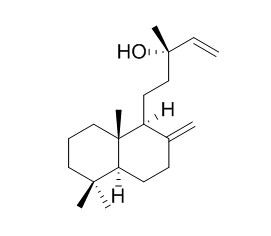13-Epimanool
Reference standards.
Inquire / Order:
manager@chemfaces.com
Technical Inquiries:
service@chemfaces.com
Tel:
+86-27-84237783
Fax:
+86-27-84254680
Address:
1 Building, No. 83, CheCheng Rd., Wuhan Economic and Technological Development Zone, Wuhan, Hubei 430056, PRC
Providing storage is as stated on the product vial and the vial is kept tightly sealed, the product can be stored for up to
24 months(2-8C).
Wherever possible, you should prepare and use solutions on the same day. However, if you need to make up stock solutions in advance, we recommend that you store the solution as aliquots in tightly sealed vials at -20C. Generally, these will be useable for up to two weeks. Before use, and prior to opening the vial we recommend that you allow your product to equilibrate to room temperature for at least 1 hour.
Need more advice on solubility, usage and handling? Please email to: service@chemfaces.com
The packaging of the product may have turned upside down during transportation, resulting in the natural compounds adhering to the neck or cap of the vial. take the vial out of its packaging and gently shake to let the compounds fall to the bottom of the vial. for liquid products, centrifuge at 200-500 RPM to gather the liquid at the bottom of the vial. try to avoid loss or contamination during handling.
Nutrients.2024, 16(16):2612.
Vietnam Journal of Food Control.2022, 5(3):pp.488-497.
Pathol Res Pract.2024, :260:155445.
Mol Pharm.2017, 14(9):3164-3177
Earth Environ. Sci. 2021, 905:012080.
Research Square2021, 10.21203.
Molecules.2024, 29(11):2626.
Journal of Functional Foods2022, 98:105271.
Comparative Clinical Pathology 2021, 30:961-971.
Pharmacognosy Journal, 2021, 13(5).
Related and Featured Products
Chem Biodivers. 2007 Mar;4(3):531-8.
Labdane diterpenoid glycosides from Aster veitchianus.[Pubmed:
17372956]
METHODS AND RESULTS:
Four new labdane-type rhamnopyranosides derived from 13-Epimanool, compounds 1-4, with differently acetylated sugar moieties, were isolated from A. veitchianus. Their structures and absolute configurations were elucidated by chemical transformation, spectroscopic and mass-spectrometric analyses (IR, 1D- and 2D-NMR, HR-ESI-MS), as well as by single-crystal X-ray diffraction (compound 1).
CONCLUSIONS:
The isolates 2-4 were investigated for their cytotoxic properties against cultured human hepatoma (SMMC-7721), ovarian neoplasm (HO-8910), and leukemia (HL-60) cells, and for their antibacterial activities against Escherichia coli, Bacillus subtilis, and Staphylococcus aureus.
J Agric Food Chem. 2012 Jan 11;60(1):124-8.
Phytochemicals from Cunninghamia konishii Hayata act as antifungal agents.[Pubmed:
22129092 ]
The aims of the present study were to isolate and identify the antifungal compounds from the ethanolic extract of Cunninghamia konishii wood and to evaluate their antifungal activities against wood decay fungi.
METHODS AND RESULTS:
The results showed that the n-Hex soluble fraction of the ethanolic extract from C. konishii wood had an excellent inhibitory effect against Lenzites betulina, Trametes versicolor, Laetiporus sulphureus, and Gloeophyllum trabeum, with IC(50) values of 33, 46, 62, and 49 μg/mL, respectively. By following the bioactivity-guided fractionation procedure, four sesquiterpenes, T-cadinol, cedrol, T-muurolol, and (-)-epi-cedrol, and three diterpenes, 13-Epimanool, cis-abienol, and isoabienol, were identified from the active subfractions. Among the main constituents of the ethanolic extract from C. konishii, T-cadinol, cedrol, and T-muurolol efficiently inhibited the growth of four wood-rot fungi at the concentration of 100 μg/mL, with antifungal indices of 51.4-100.0%, 68.3-100.0%, and 39.5-100.0%, respectively.
CONCLUSIONS:
Results of this study show that the ethanolic extract of C. konishii wood may be considered as a potent source of T-cadinol, cedrol, and T-muurolol as new natural antifungal agents.



